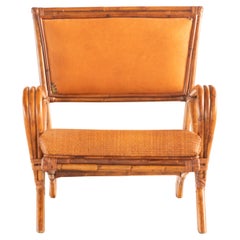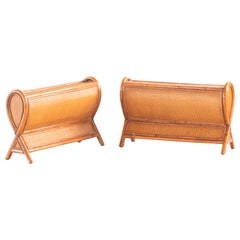Modern Kalma
Recent Sales
Rattan Split Chair Wood Confortable Modern Asian Modern Kalma Furniture
By Eastern Artisans
Located in Milano, IT
confortable chair.
Modern chair stamped for Kalma in Bamboo Wood, 20th century. Collapsible rattan base
Category
Vintage 1980s Chinese Chinese Export Jewelry Boxes
Materials
Leather, Bamboo, Cane, Rattan, Wood
H 32.29 in W 28.75 in D 29.53 in
Rattan Handmade Woven Cane Kalma Coffee Bow Table Modern Footrest Furniture
By Eastern Artisans
Located in Milano, IT
. Stamped Kalma Ramon Castellano in Bamboo Wood, 20th Century. High quality bamboo and rattan collection
Category
Vintage 1980s Chinese Chinese Export Jewelry Boxes
Materials
Bamboo, Rattan
H 16.93 in W 28.75 in D 11.42 in
Mid-Century Modernist Sculptural Icicle Sconces with Chrome Fittings by Kalma
By Kalmar Lighting
Located in New York, NY
A very beautiful pair of Mid-Century Modernist sculptural glass sconces by Kalmar. Nine vertical segments are arranged in a staggered manner and secured by chrome fittings and frame....
Category
Vintage 1960s German Mid-Century Modern Wall Lights and Sconces
Materials
Chrome
Get Updated with New Arrivals
Save "Modern Kalma", and we’ll notify you when there are new listings in this category.
Modern Kalma For Sale on 1stDibs
With a vast inventory of beautiful furniture at 1stDibs, we’ve got just the modern kalma you’re looking for. Frequently made of bamboo, natural fiber and rattan, every modern kalma was constructed with great care. Whether you’re looking for an older or newer modern kalma, there are earlier versions available from the 20th Century and newer variations made as recently as the 20th Century. Each modern kalma bearing mid-century modern hallmarks is very popular. Anna Maria Hoke each produced at least one beautiful modern kalma that is worth considering.
How Much is a Modern Kalma?
The average selling price for a modern kalma at 1stDibs is $1,840, while they’re typically $542 on the low end and $25,500 for the highest priced.
More Ways To Browse
Portuguese Contador
Venetian Jewelry Box
Wendell Castle Box
African Ceramic Head
Antique French Ring Box
Antique Leather Casket
Birks Jewelry Box
Bombe Jewelry Box
Coffin Box
Coromandel Mirror
Heart Shaped Jewelry Box
Jewelry Box Zebra Wood
Jewelry Display Table
Moroccan Silver Jewelry Box
Vintage Alpaca Mexico Jewelry
Vintage Jewelry Box Pulls
Vintage Uranium Jewelry
17th Century Dutch Jewelry

